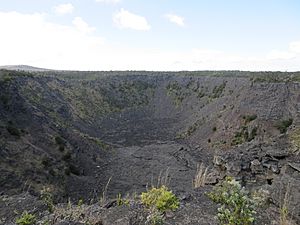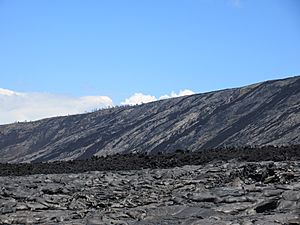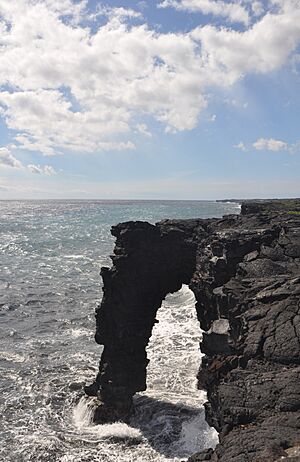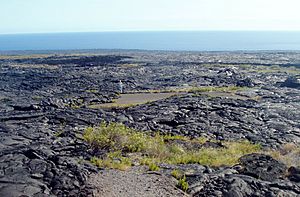Chain of Craters Road facts for kids
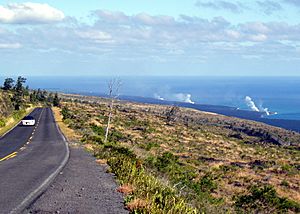
The Chain of Craters Road is a famous road in Hawaii Volcanoes National Park on the Big Island of Hawaii. It's about 19-mile (31 km) long and winds through volcanic areas and along the coast. This road was first built in 1928. It was later made longer in 1959 to reach the small town of Kalapana.
What makes this road special is that it's often covered by lava! Since 1965, parts of the road have been buried by lava flows from the Kīlauea volcano in 41 out of 53 years. This means the landscape around the road is always changing because of the volcano's eruptions.
Contents
Exploring Chain of Craters Road
This road offers amazing views and chances to see unique volcanic features. You can find paths and side roads that lead to different craters, old lava flows, and even steam coming from underground lava tunnels. The road also passes through beautiful tropical rainforests and offers stunning coastal views.
Near the park's visitor center, there's another road called Crater Rim Drive. It's about 10-mile (16 km) long and goes around the Kīlauea caldera (a large volcanic crater). A short road from there leads to a viewpoint where you can see Kīlauea, which is where a big eruption started in 1995.
Journey Through Volcanic Landscapes
The Chain of Craters Road starts high up in an area called the East Rift Zone. Because it rains a lot here, you'll see a lush rainforest. About 3 mi (4.8 km) down the road, you pass the main opening of the Kīlauea volcano.
The road continues for another 2 mi (3.2 km), passing several craters that give the road its name. Then, it crosses a smooth type of lava called pāhoehoe lava that flowed here in 1974.
Discovering Pit Craters
The first pit crater you'll see is Lua Manu. A pit crater forms when the ground sinks, not when lava erupts from it. In 1974, lava spilled into Lua Manu but didn't completely fill it.
Next is Puhimau, another pit crater, which is about 500 feet deep and filled with rubble. Then comes Koʻokoʻolau, a dirt pit crater. These craters don't show signs of recent eruptions. However, Koʻokoʻolau has small pumice cones on its edge, suggesting it might have been an eruptive vent long ago.
The road also connects to Hilina Pali Road, an eight-mile road that ends without an exit. You'll pass Pauahi crater and fresh fault scarps (steep slopes formed by earth movements) that have been active for over 1,000 years. The road then goes through a forest called Kipuka Nene, where ancient 1,100-year-old trees stand surrounded by newer lava flows.
As you get closer to the sea, the road crosses more pāhoehoe lava flows. Here, you might even see steam rising from lava tubes, which are like underground tunnels where lava once flowed.
How Lava Changes the Road
Lava flows from the Kīlauea volcano have often closed parts of Chain of Craters Road. For example, a big eruption closed the road in 1969. It reopened in 1979 but was cut again in 1986 by another lava flow from Kīlauea.
As of 2014[update], the road is about 19 miles (30 km) long, ending at the Holei Sea Arch. Another 7.5 miles (12 km) of the original road are now buried under lava from different flows from Puʻu ʻŌʻō since 1986. Overall, the road drops about 3,700 feet (1,130 m) from Crater Rim Drive down to the south coast.
In 2014, workers tried to reopen Chain of Craters Road as a gravel path. This was meant to be an emergency route for people living in Lower Puna, in case a lava flow cut off their main highway. However, the lava flow stopped before reaching the highway, and the emergency route was later covered by lava again in 2016. In 2018, another eruption caused similar repairs, but the road is still mostly closed to regular cars for safety reasons.
Safety and Conditions
The Puʻu ʻŌʻō eruption, which lasted 35 years, ended in 2018. Even without active lava, Chain of Craters Road is a very scenic drive. However, it can be dangerous if conditions are poor. Because it's near an active volcano, the US Geological Survey provides daily updates on conditions. For example, in April 2008, the area was on high alert due to volcanic activity and the presence of sulfuric gas, which can be harmful.
Services Along the Road
There are no shops or gas stations along Chain of Craters Road. However, at the very end of the road, where lava has blocked further access for cars, you can find a small refreshment stand and public restrooms. Remember to bring everything you need for your trip before you start driving!


